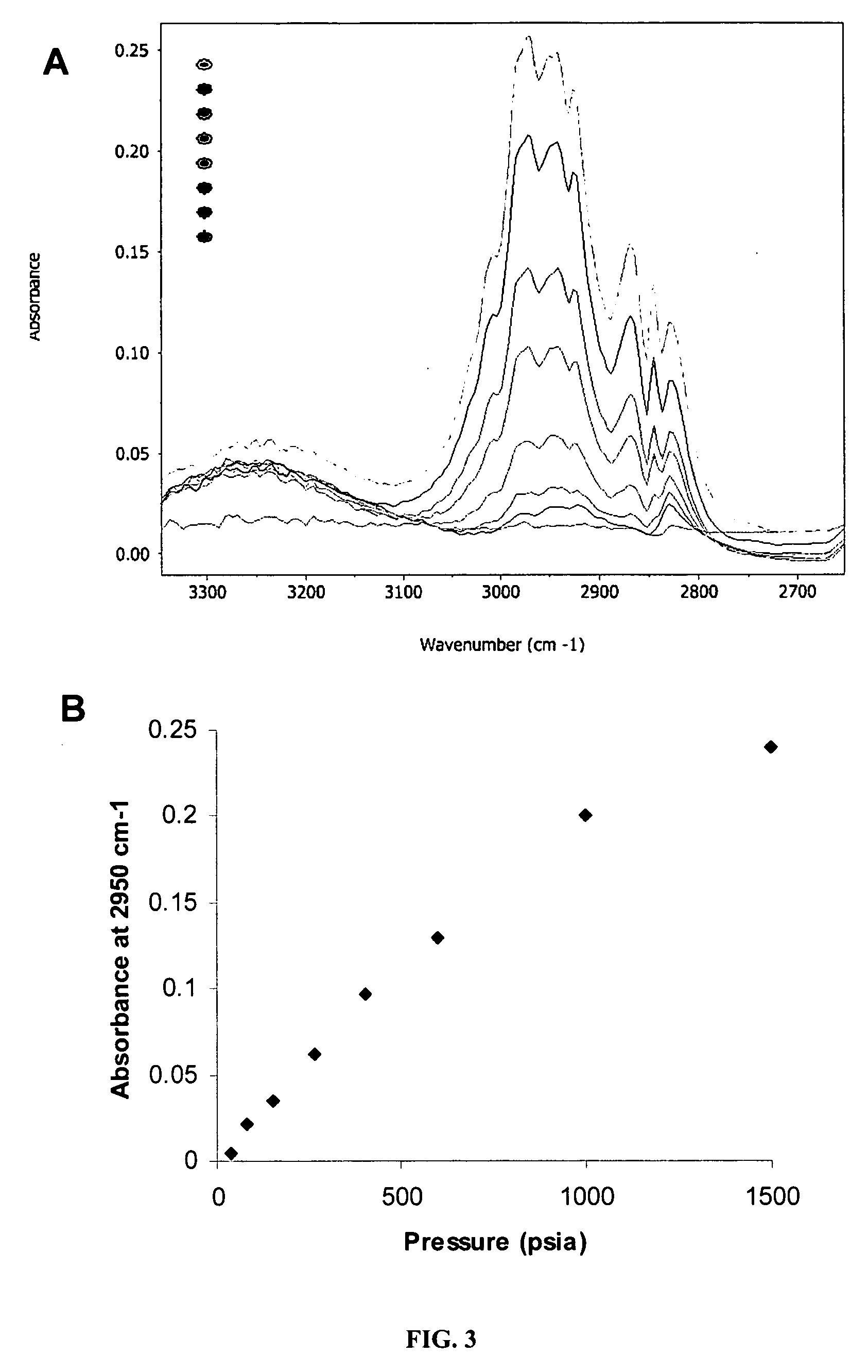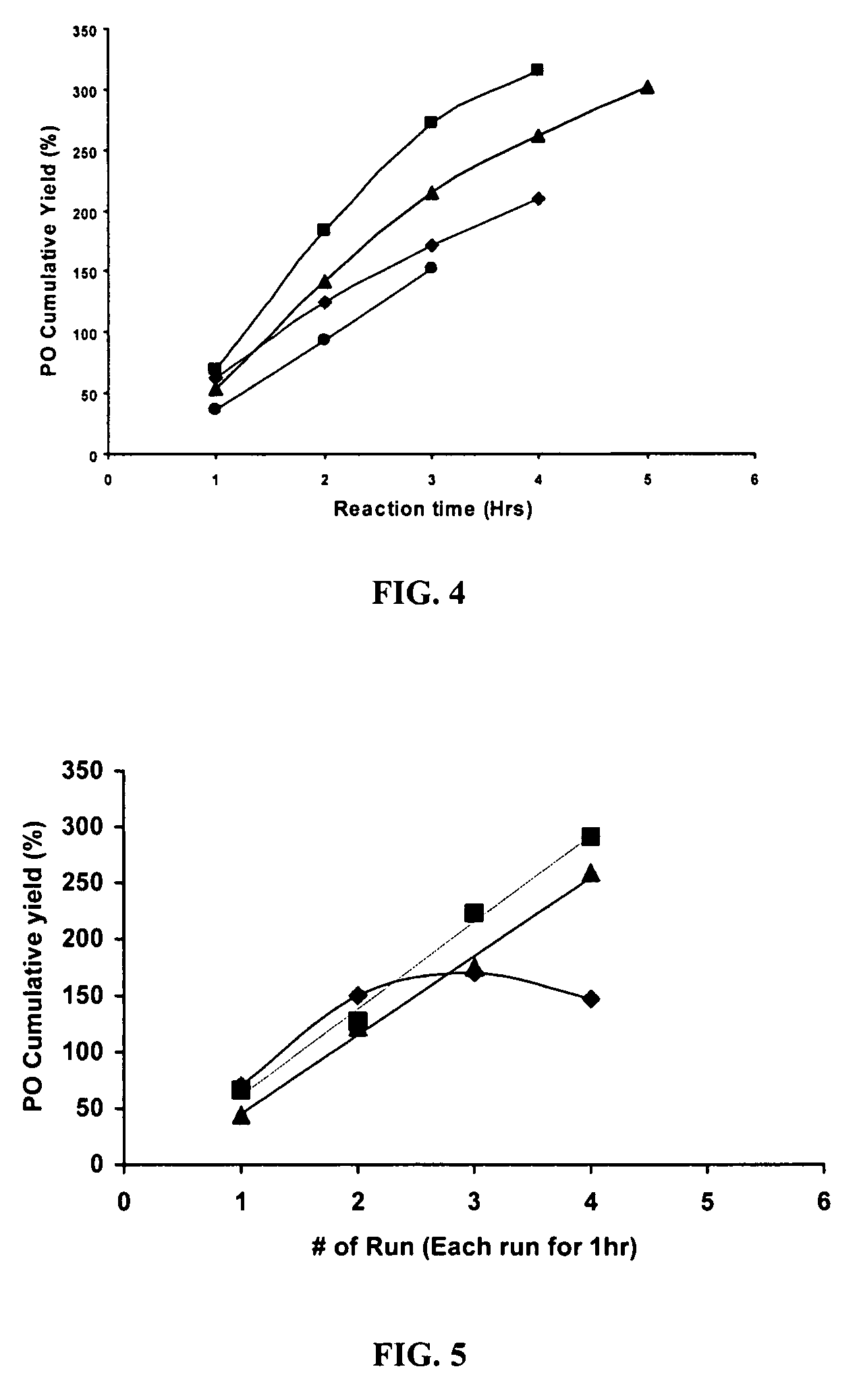Process for selective oxidation of olefins to epoxides
a technology of olefins and epoxides, applied in chemical recycling, organic chemistry, etc., can solve the problems of large amount of chlorine and lime consumed by the process, difficulty in implementing, and difficulty in implementing, and achieve stable catalyst performance, high propylene oxide formation activity, and rapid deactivation
- Summary
- Abstract
- Description
- Claims
- Application Information
AI Technical Summary
Benefits of technology
Problems solved by technology
Method used
Image
Examples
example 1
Oxidation of Propylene with Carbon Dioxide as the Pressurizing Gas
[0036] In this example, the effect of adding dense carbon dioxide to the reaction mixture was investigated in various organic solvent systems and bases. More specifically, in this example, the reactor was charged with 0.0120 g (0.049 mmol) MTO, 0.610 ml aqueous hydrogen peroxide (50 wt % in water, density 1.18 g / ml) (10.58 mmol) in either 4.14 ml methanol or 4.0 ml acetonitrile as the organic solvent, with 0.40 ml (4.965 mmol) pyridine or 0.049 g (0.51 mmol) pyridine N-oxide as the base.
[0037] After introduction of 100 mg (2.376 mmol) propylene, carbon dioxide (2.37 ml, about 700 psi at 25° C.) was then added to the reactor by bubbling through the liquid at a predetermined pressure (700 psi) selected to produce a single liquid phase in the reactor. In addition to the carbon dioxide pressure, the reaction mixture compositions were chosen to produce a single liquid phase in the reactor. The reaction was monitored for ...
example 2
Propylene Solubility in Methanol / Water Solvent System at Different Pressures
[0040] In this example, the propylene solubility in the methanol / water solvent system was investigated at different pressures. A methanol / water weight ratio of 6:1 was used in this example. In this example, propylene was fed to the reactor to reach various system pressures by adjusting the amount of propylene. The solubility of propylene in the liquid phase was measured by GC equipped with both capillary and packed columns. At 40° C., the mole fraction of propylene in the liquid phase is shown in FIG. 2 and increases, as expected, with applied propylene pressure.
example 3
Effects of Different Bases on Propylene Oxide Yield and Selectivity
[0041] In this example, several different organic nitrogen-containing bases were investigated to determine effects on yield and selectivity. More specifically, in this example, the reactor was charged with 0.0120 g (0.049 mmol) MTO, 0.610 ml aqueous hydrogen peroxide (50 wt % in H2O) in 4.14 ml methanol as the organic solvent and a base as set forth in Table 2 below. Carbon dioxide (700 psi) was added as in Example 1. The bases tested included pyridine, pyridine N-oxide, 4,4′-dipyridyl, 2,2′-dipyridyl N,N′-dioxide, 2,2′-6,2″-terpyridine, 2,4,6-tri(4-pyridyl)-1,3,5-triazine, and diphenylamine were studied in search of the optimal co-factor for propylene oxidation. As shown in the table below, pyridine-N-oxide produced the highest yield in methanol at 40° C. in the presence of 700 psi carbon dioxide.
TABLE 2Base Effect of Propylene Oxidation with MTO for 3-Hour Reaction inCarbon-Dioxide Expanded LiquidReactionYield o...
PUM
| Property | Measurement | Unit |
|---|---|---|
| wt % | aaaaa | aaaaa |
| pressure | aaaaa | aaaaa |
| pressure | aaaaa | aaaaa |
Abstract
Description
Claims
Application Information
 Login to View More
Login to View More - R&D
- Intellectual Property
- Life Sciences
- Materials
- Tech Scout
- Unparalleled Data Quality
- Higher Quality Content
- 60% Fewer Hallucinations
Browse by: Latest US Patents, China's latest patents, Technical Efficacy Thesaurus, Application Domain, Technology Topic, Popular Technical Reports.
© 2025 PatSnap. All rights reserved.Legal|Privacy policy|Modern Slavery Act Transparency Statement|Sitemap|About US| Contact US: help@patsnap.com



